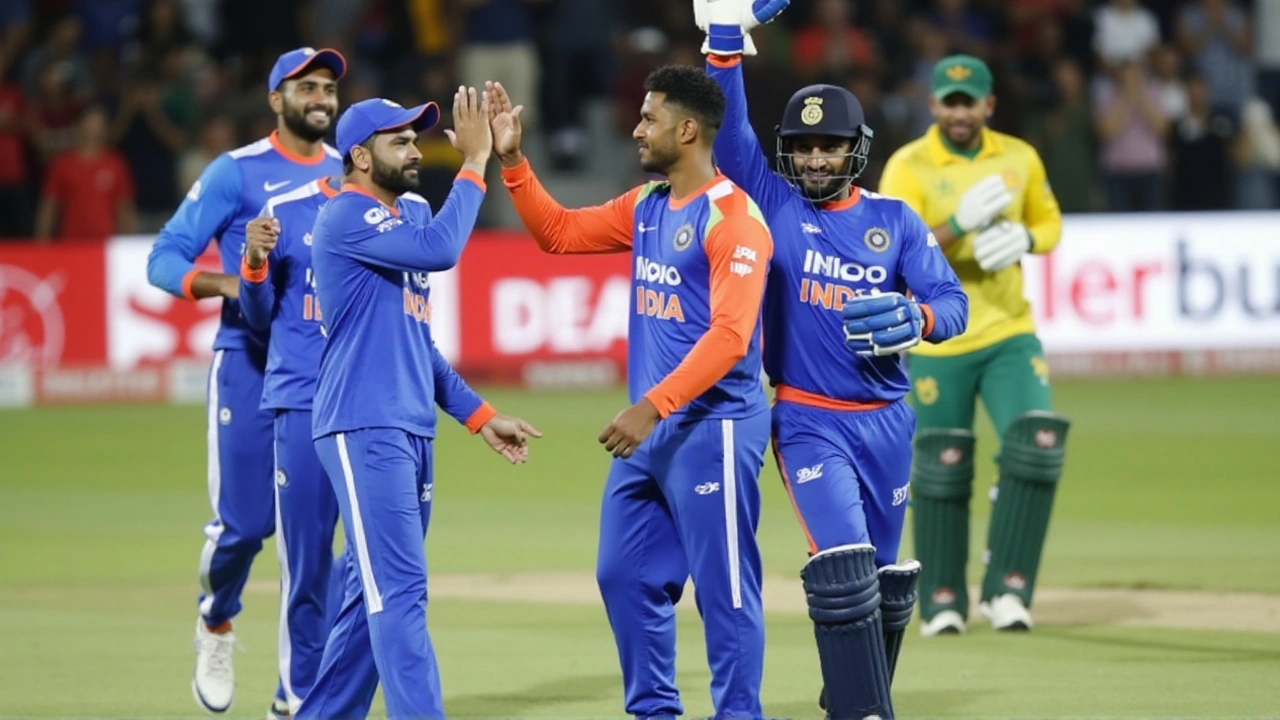India vs South Africa: A Thrilling Encounter on the Field
The highly anticipated second T20I between India and South Africa unfolded at St George's Park, Gqeberha. Both teams stepped on the field with great expectations riding on their shoulders, especially India, who were on a remarkable 11-match winning streak. Fans were also on the edge of their seats, eager to see whether Sanju Samson could achieve an unprecedented hat-trick of centuries in T20I cricket. The game, however, turned into a dramatic contest that saw South Africa narrowly clinching victory by 3 wickets, leaving the series divided at one win each.
Sanju Samson's Anticipated Milestone
Sanju Samson entered the fray with remarkable form, having delivered two consecutive centuries in the previous matches. The prospect of Samson achieving a third consecutive ton was a thrilling subplot to the main event. His prowess as a batsman had already been pivotal in India's first T20I triumph, where his aggressive batting style and precise shot selection paved the way for a convincing win. Expectations were sky-high as he took to the pitch, but the cricket gods had a different narrative in store. Despite his intentions and talent, Samson found himself unable to replicate the heist of his earlier performances, leaving fans with mixed feelings of anticipation and disappointment.
Varun Chakaravarthy: A Beacon in the Bowling Lineup
In contrast to the batting woes, Varun Chakaravarthy emerged as the bright spot in India's squad. His stellar bowling performance was the talk of the match, as he skillfully claimed five wickets, keeping the South African batsmen on their toes. Chakaravarthy's spinning deliveries were a sight to behold—each one a blend of precision and unpredictability that left even the most seasoned batsmen perplexed. His five-wicket haul brought India moments of hope, akin to rays of sunlight piercing through heavy storm clouds. However, his solo efforts, although exceptional, could not seal the deal for India on that particular day.
South Africa's Resilience in the Face of Pressure
Tristan Stubbs became the anchor for South Africa's chase, playing a crucial role against a formidable Indian bowling attack. His ability to remain unruffled under pressure and capitalize on scoring opportunities allowed him to steer his team towards a notable victory. The match teetered in balance multiple times, yet Stubbs's calm demeanor and strategic shot execution were instrumental in swinging the pendulum in South Africa's favor. His innings embodied the grit and determination that often differentiate winners from the rest.
Cultural and Contextual Narrative
Cricket between India and South Africa is not just a sporting event—it's a celebration of contrasting cultures and cricketing philosophies. Each match is a chapter in a storied rivalry, punctuated by intense auras of nationalism and sporting spirit. The second T20I was a reflection of this ongoing tale. The ebb and flow of the game, along with its unexpected moments of brilliance and despair, mirrored the unpredictability that draws millions to this beloved sport. For the Indian team, it was a reminder of the challenges inherent in maintaining dominance atop the cricket pyramid. For South African players and their supporters, it was a reaffirmation of their ability to rise against odds and etch a legacy of their own.
The Road Ahead: Third T20I
With the series now delicately poised at 1-1, the upcoming third T20I promises to be pivotal. Both teams will strategize to exploit their opponent’s weaknesses while bolstering their own areas of strength. India will be driven to reclaim momentum, looking to avoid the mistakes of this matchup and relying on the blend of experience and young talent within their ranks. South Africa, on the other hand, will hope to build on this victory and press home their advantage, knowing well that the series is within their grasp. Fans around the world eagerly await the next chapter in this thrilling cricket saga, hoping once more for a feast of skill, sportsmanship, and excitement.




Varun's five‑wicket spell was a real spark, but cricket’s a team game and India just fell short this time.
Life’s a spin, just like Chakaravarthy’s wrist.
Statistically, India’s batting collapse after 60 runs cost them. If they manage a 20‑run partnership early, the chase becomes manageable.
Exactly the point – the middle order needs to reset quickly. No need for over‑analysis, just play each ball on its merit.
Honestly, I was hoping Samson would smash another ton, but the pitch was a bit tricky and the bowlers just got the better of him.
😂 Honestly, everyone’s hyped about Samson but the real story is Stubbs pulling off a clutch finish. South Africa deserved the win – no doubt! 🙌
It’s a stark reminder that Indian cricket cannot rely on individual brilliance; the collective must dominate. Deploying a balanced attack and ensuring depth in batting is non‑negotiable if we want to retain the top spot on the global ladder.
The contest showcased the beautiful juxtaposition of styles – Indian spin versus South African resilience. Both sides displayed commendable sportsmanship.
Nice try, India, but you’ve been out‑witted again – classic South African chase. Guess the hype around Samson was just that, hype.
While I respect the competitive spirit displayed, it is imperative to acknowledge the strategic missteps that led to the sub‑optimal outcome for India.
The drama unfolded like an ancient epic, each over a stanza in a saga of hope and heartbreak. Varun’s spinning wizardry painted arcs across the sky, each delivery a whispered promise of redemption. Yet the batsmen, like reluctant protagonists, faltered under the weight of expectation. The stadium’s roar crescendoed, then dimmed, as wickets fell like tragic verses. South Africa’s Stubbs emerged from the shadows, a stoic figure carving his path through the tempest. His bat sang a melodic counter‑theme, each stroke a defiant chorus against the Indian onslaught. The tension was palpable; every run became a heartbeat, every dot ball a sigh of the collective audience. When the final ball swung, the match slipped into a nail‑biting climax, the sands of destiny shifting in favor of the visitors. Victory was snatched by three wickets, a slender margin that spoke volumes about the fine line between triumph and defeat. The Indian side, though bruised, displayed flashes of brilliance that will echo in future encounters. For the fans, this contest was a reminder that sport thrives on unpredictability, on moments that linger beyond the scoreboard. As the teams retire to the locker rooms, the lessons etched in that game will shape strategies for the upcoming third T20I. The spirit of competition remains alive, and the rivalry sizzles with renewed vigor. In the annals of cricket, this match will be recalled as a testament to resilience, skill, and the ever‑turning wheel of fortune.
Looking ahead, the third T20I will be decisive; both squads must fine‑tune their tactics, especially India’s middle order, while South Africa should capitalize on the momentum gained.
True that, but India also needs to shuffle the batting order a bit; maybe send in a more aggressive player at number 4.
Strategic recalibration is essential; altering the sequence can disrupt the opposition’s plans and restore the batting confidence needed for a chase.
The match highlighted the importance of adapting to pitch conditions quickly, something both teams can improve upon.
Yeah, adapting fast is key. Also, keeping the morale high helps players perform better under pressure.
Indeed, sustained confidence and tactical flexibility are the cornerstones of success in high‑stakes T20 encounters.